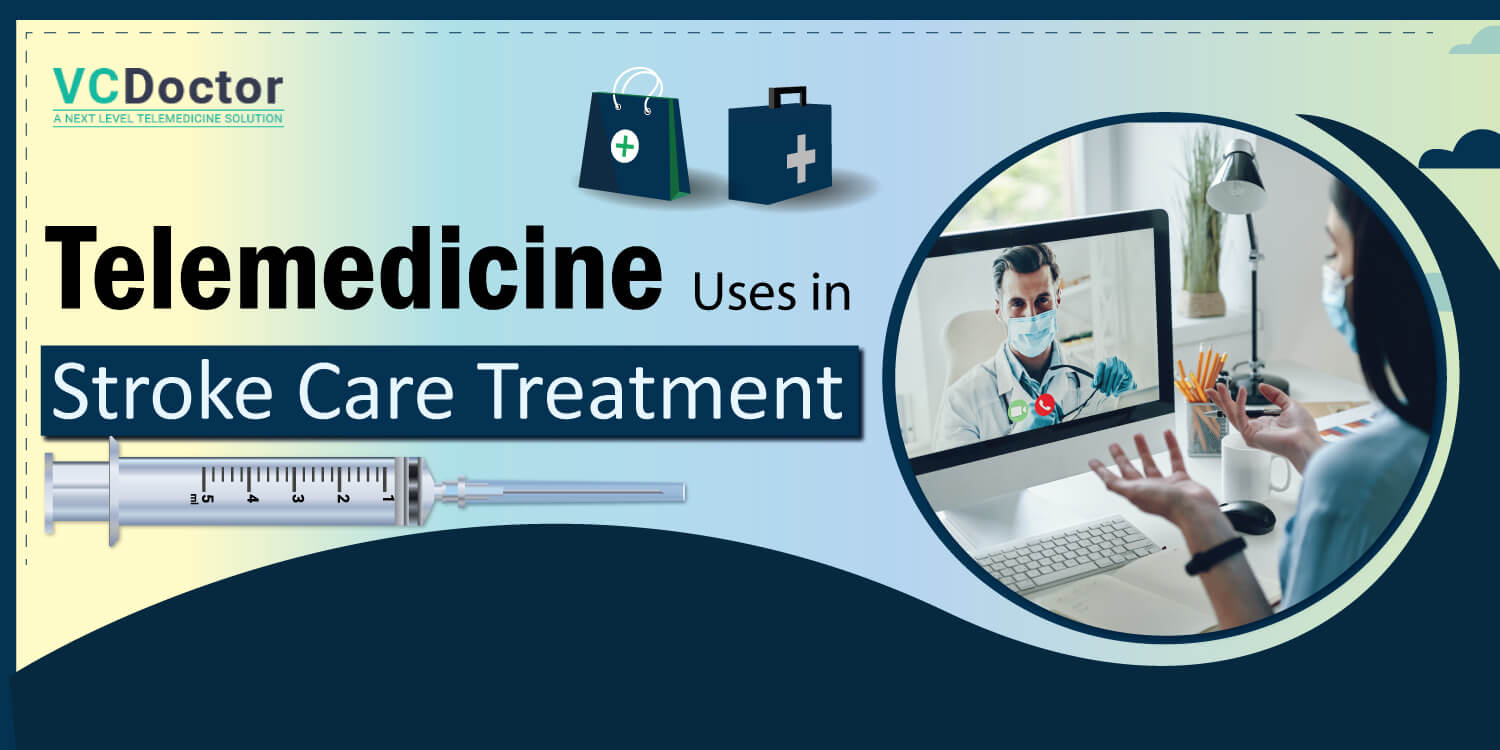Telemedicine Uses in Stroke Care Treatment
Given the incidence of stroke and the aging of our population, improved stroke care is a public health priority. Telemedicine for stroke care is undoubtedly a positive development in the field of neurology.
Stroke is one of the most debilitating brain conditions. It is the world’s second leading cause of death and a leading source of disability. The prevalence of stroke is highest among adults.
Stroke is anticipated to become more common as the population ages, with stroke prevalence expected to grow by roughly 22% by 2030. The impact, benefits, and limitations of Telestroke are discussed in this blog.
What Exactly is Telestroke?
Telestroke, often known as stroke telemedicine, is a service that provides stroke expertise to remote sites with limited or no vascular neurology coverage using remote expertise and resources, as well as process standardization It is a subdivision of teleneurology, involving telemedicine video consultation for the treatment of neurovascular patients.
HIPAA Compliant Telemedicine Solution
Best HIPAA compliant telemedicine solution for providers. 24*7 care delivered on patients’ mobile.
Request a QuoteWhat is The Purpose of Telestroke?
The primary goal of telestroke is to save lives by providing a rapid virtual examination to a suspected stroke patient via video, which includes a review of imaging and a recommendation for or against the use of a clot-busting drug.
Telestroke is most commonly used for acute stroke patients (prehospital and hospital), but telemedicine services can be used well before and after that time frame, and they can provide a wide range of additional services, including wellness, remote monitoring, disease prevention, subacute, rehabilitative, and reintegration into the community.
What Does the Telestroke Network Consist of?
Telestroke networks are made up of originating sites, which are where the patients are, and distant sites, which are where the telestroke provider is. Before we can discuss telestroke networks, it’s vital to understand the language used by the American Telemedicine Association to describe telestroke systems.
- Distant site: The location of the telestroke provider
- Originating site: The patient’s location
- Telestroke network: A group of primary, secondary, and tertiary care settings that deliver acute stroke care to the patient
- Spoke: A telestroke network affiliate or a partner site that is underserved or under-supported by neurologists.
- Hub: A full-fledged tertiary care facility with neurologists and other acute stroke experts Telestroke services are provided by this center to network partner sites (i.e., spoke sites). If the patient requires a higher degree of treatment, they will be sent to this facility.
Common Telestroke Models:
- Hub and spoke model: For extending quality acute stroke care to remote hospitals
- Horizontal hubless network: Teleconsultations during off-hours are performed by local neurologists of all hospitals involved in the network in rotation
- Third-party distribution model: Network hospitals hire a third-party vendor to provide consultations
- Supervisory training model: For training and education
Within stroke telemedicine, the most widely utilized models are hub and spoke with external sites and third-party distribution models. The majority of spoke sites in telestroke networks are small hospitals (i.e., 0–99 beds), but spoke hospital sizes can range from 25 to 500 beds across different telestroke networks. The majority of telestroke hospitals have explicit written contracts in place between the hub and spoke sites, as well as a closed-loop communication mechanism.
VCDoctor Best Telemedicine Solution
Best telemedicine solution for neurologists. Quality stroke care at every stage. Know more.
Know MoreTypes of Stroke Telemedicine
All major stroke types are efficiently diagnosed and treated with telemedicine:
- Ischemic stroke is caused by a shortage of blood flow in the brain (ischemia).
- A hemorrhagic stroke occurs when a blood vessel ruptures in the brain or between the membranes of the brain.
- A mini-stroke, also known as a transient ischemic attack, is a brief period of ischemia that lasts less than two hours.
How Does Dtroke Telemedicine Work?
A patient with a suspected stroke often presents to a spoke site for a telestroke consult. If your primary care physician suspects acute stroke symptoms during a Telestroke consultation, he or she will contact a neighboring hospital’s stroke telemedicine hotline; experts are usually available 24 hours a day, 7 days a week.
The neurologist at the distant location provides a live, real-time audio/video consultation, reviews the patient’s test results, and works with your doctor to choose the best treatment option. The therapeutic recommendation is also shared with the hospital where the patient is monitored.
A choice is taken to administer tPA after analyzing the National Institute of Health Stroke Scale (NIHSS) and brain imaging and reviewing the patient’s history for tPA indications. Depending on the need for further examination, the patient may be sent to the hub location after this initial phase.
Read More: Why Telemedicine Is The Future Of Healthcare Industry: Top Reasons
Benefits of Telemedicine for Stroke Care
A Telestroke consultation aims to improve a patient’s recovery (by lowering brain damage) by providing an accurate diagnosis, evaluating eligibility for short-term therapy, and delivering the chosen treatment. Telestroke benefits include:
- Access to specialists during emergencies
- Reduced time for diagnosis and treatment
- Reduced likelihood of stroke-related impairment.
- Allows patients to continue receiving expert treatment at their local hospital, reducing the need for them to relocate to another facility.
- Increased patient treatment capacity
- Increased patient retention
- Improved rate of clot-busting drug administration
- More lives saved
COVID and Remote Health Monitoring
Fears of COVID-19 contamination in clinical settings have resulted in a significant decrease in on-site referrals for regular care. There has also been a perception that non-severe COVID-19 patients should be monitored regularly.
As a result of the pandemic, incentives have been created to develop and improve or build new routes for providing remote healthcare services. This has put a lot of pressure on researchers to come up with new ways to monitor patient health status remotely and effectively.
When using smartphone-based telemedicine solutions, awareness of stroke, depression, and blood pressure was increased. Telestroke has the potential to become a novel secondary prevention approach because of its affordability, real-time response, and ease of use.
Read More: How To Use Telemedicine For Migraines Treatment
Telerehabilitation as Good as In-Person Rehab
Telerehabilitation can be considered a branch of telemedicine. Although a relatively new concept, it has seen remarkable growth in recent years. There is moderate-to-good quality consistent data to suggest that telerehabilitation may be as successful as in-person rehab.
The global healthcare infrastructure was caught unprepared by the Covid-19 pandemic. Telemedicine for Stroke care was disrupted, with in-person rehabilitation services being drastically decreased or discontinued.
Several comprehensive reviews have concluded that telerehabilitation is useful in the recovery of motor function in patients with neurological diseases. Telerehabilitation treatments for stroke have quickly become commonplace around the world as a viable alternative to inpatient care. Telerehabilitation can help with functional recovery, motor recovery, communication, depression, and stroke risk factors, among other things (eg, exercise, and diet to reduce blood pressure).
According to some research, telerehabilitation can also save health-care costs, improve therapy adherence, improve physical and mental function and quality of life, and be given in a patient-friendly manner.
Read More: What Are The Benefits Of Telemedicine In Mental Health Care?
Conclusion
The COVID-19 epidemic has been disruptive, but it has also produced an environment conducive to innovation, especially in terms of widespread adoption and the use of telemedicine in rural areas. While telemedicine is safe and effective for making medical decisions in acute stroke, the pandemic has accelerated the adoption and integration of telemedicine across the stroke care continuum.
We anticipate that the enlarged telestroke care continuum will last long after the crisis has passed. Telemedicine for Stroke Care is still in a budding stage. As technology will evolve, so would the effectiveness and efficacy of telestroke in stroke care and treatment. Get in touch with our experts for more information




